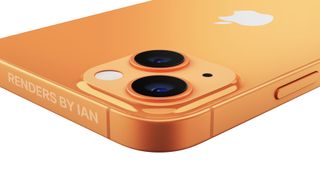iPhone 13 and iPhone 13 mini storage rumor is an insult
It looks like the iPhone 13 and iPhone 13 mini will start with 64GB of storage

Apple might have made its first misstep with the iPhone 13, and the new phones aren't even out yet. New information posted about the upcoming iPhone's rumored specs suggests that one of the biggest drawbacks to Apple's devices isn't getting addressed in this update.
That would be the storage Apple includes on the standard iPhone and the mini model. While the iPhone 12 Pro and iPhone 12 Pro Max come with a hearty 128GB of storage, the iPhone 12 and iPhone 12 mini do not. Instead, you get 64GB with the base model, and the only way to add more is to opt for a pricier 128GB version, since Apple doesn't include microSD slots with its smartphones.
- What to expect from the iPhone 13 vs. iPhone 13 Pro
- iPhone 13 colors — here's what the rumors say
- Plus: iPhone 13 leaker just tipped biggest upgrades ahead of Apple event
There had been hope in some quarters earlier this summer — well, from me specifically — that Apple might join other flagship phone makers and boost the starting capacity for its two least expensive iPhones. A listing at a Ukrainian e-commerce site that claims to detail the iPhone 13 colors and storage configurations puts the kibosh on that, though. The iPhone 13 and iPhone 13 mini are listed with 64GB and 128GB storage options.
Now there's an old saying in technology reporting: Just because it's prematurely listed on a Ukrainian e-commerce site doesn't mean that it's true. There's no guarantee the listings at the KTC website are accurate. Apple could still come out a 128GB base model iPhone 13 at its Sept. 14 product event, and I could wind up with egg on my face. Frankly, I hope that the case.
Because I'd far rather be embarrassed by a premature rant about smartphone storage than face a world where a major phone maker was still convinced that 64GB was acceptable as the base storage for a flagship phone.
Assuming the iPhone 13 and iPhone 13 mini cost the same as their predecessors — that's $799 and $699, respectively — other phones in that price range seem to have gotten the memo on how much storage phone users need these days. The $799 Samsung Galaxy S21 has 128GB of storage. So does the $729 OnePlus 9. Heck, even last year's Galaxy S20 FE — a phone that scaled back on features in the name of keeping its price tag down — features 128GB of storage.
Storage in Phones that cost $799 and less
| Phone | Base model storage | microSD? | Price |
| Samsung Galaxy S21 | 128GB | No | $799 |
| Samsung Galaxy S20 FE | 128GB | Yes | $699 |
| Samsung Galaxy A52 5G | 128GB | Yes | $499 |
| OnePlus 9 | 128GB | No | $729 |
| Google Pixel 5a | 128GB | No | $449 |
Even with companies like Apple pushing people toward cloud-based storage services like iCloud, 64GB is just too little storage these days. Starting with the fact that the full 64GB aren't available to you — the software operating your phone eats up a small chunk right out of the gate — your phone can fill up pretty quickly on photos, music, files and apps. I'm currently using an iPhone 11 Pro Max for most of my daily tasks, and though I live a pretty spartan existence when it comes to files, I've still had to make use of the offload apps feature to free up space for some updates.
Sign up to get the BEST of Tom’s Guide direct to your inbox.
Upgrade your life with a daily dose of the biggest tech news, lifestyle hacks and our curated analysis. Be the first to know about cutting-edge gadgets and the hottest deals.
Apple could have plenty of reasons for starting storage options at 64GB. The fact that we're talking about the two least expensive flagship options in the iPhone lineup suggests that it probably has something to do with keeping costs down. Either that, or Apple is looking to further differentiate its Pro models from the standard and mini versions of its phones.
I don't pretend to know Apple's thinking here. But I do know that storage is one area where Apple's rivals don't skimp. And that makes the iPhone stand out in a different way — one that Apple probably wouldn't like as much.
It seems like plenty of marquee features are rumored for the iPhone 13 Pro models, from fast-refreshing displays to improved ultrawide angle lenses. In other words, there's already enough that's going to distinguish the iPhone 13 Pro from the less expensive new iPhones. Storage doesn't need to be included in that category.
Philip Michaels is a Managing Editor at Tom's Guide. He's been covering personal technology since 1999 and was in the building when Steve Jobs showed off the iPhone for the first time. He's been evaluating smartphones since that first iPhone debuted in 2007, and he's been following phone carriers and smartphone plans since 2015. He has strong opinions about Apple, the Oakland Athletics, old movies and proper butchery techniques. Follow him at @PhilipMichaels.

